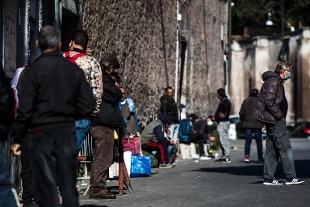- IMF: virus can push one hundred million people to extreme poverty
- Istat, Freguja: "Beware of inequalities and poverty, effects of the pandemic"
- Poverty risk, Istat: 16.4 million Italians (27.3%) on the thread of social exclusion
Share
June 16, 2020 In 2019 absolute poverty is falling. There are almost 1.7 million families in conditions of absolute poverty with an incidence of 6.4% (7.0% in 2018), for a total number of almost 4.6 million individuals (7.7% of the total , 8.4% in 2018). Istat has made it known in the report on poverty.After four years of increase, the number and share of families in absolute poverty are decreasing for the first time while remaining on levels much higher than those preceding the crisis of 2008-2009.
The number of families in conditions of relative poverty is stable: in 2019 there are just under 3 million (11.4%) which corresponds to 8.8 million people (14.7% of the total).
8.6% families in absolute poverty in the South
In particular, in the South, family poverty falls from 10% to 8.6% and individual poverty from 11.4% to 10.1%. The poverty of resident individuals also recorded a significant reduction in the Center, from 6.6% in 2018 to 5.6%.
The decrease in absolute poverty is largely due to the improvement, in 2019, of the spending levels of the poorest families. The positive trend occurred in conjunction with the introduction of the Income of citizenship (which replaced the Income of inclusion) and involved, in the second half of 2019, over one million families in difficulty. The intensity of poverty, i.e. how much the monthly expenditure of poor families is on average below the poverty line in percentage terms ("how poor the poor are") is equal to 20.3% (19.4% in 2018) with values ranging from a minimum of 18.1% in the Center and a maximum of 21.6% in the South.
The incidence of families in absolute poverty is higher in the South (8.5% in the South and 8.7% in the Islands) compared to the other divisions (5.8% in the Northwest, 6.0% in the Northeast and 4.5% in the Center). For this reason, even if the families of the North are more than those of the South (respectively 47.8% and 31.7% of the total), the number of poor families in the two divisions is substantially equal: 43.4% per North and 42.2% in the South and Islands, the remaining 14.4% are located in the Center (compared to 20.5% of households residing in this division).
Poverty incidence foreigners at 26.9%, Italians at 5.9%
Foreign citizens in absolute poverty are almost one million and 400 thousand, with an incidence equal to 26.9%, against 5.9% of Italian citizens. The families in absolute poverty are composed in 69.6% of cases by families of only Italians (one million and 164 thousand) and for the remaining 30.4% by families with foreigners (about 510 thousand), even though they represent only 8.9 % of total households.
According to the European Union of Cooperatives (Uecoop) in relation to the latest Istat data, "there are also 51 thousand invisible homeless people living on the sidewalks, in the stations and under the arcades of Italian cities among the poor who live in Italy". For Uecoop, this is "an uneasy situation that worsened in 2020 with the coronavirus emergency and that also affects clochards, children in discomfort, separated fathers and the elderly. More than 8 out of 10 homeless people are male and more than half of the cases are foreigners. Among the almost 4.6 million poor in Italy for about 1/3 sods, they are men and women over 65 who cannot pay for a full meal or electricity and heating bills. "

